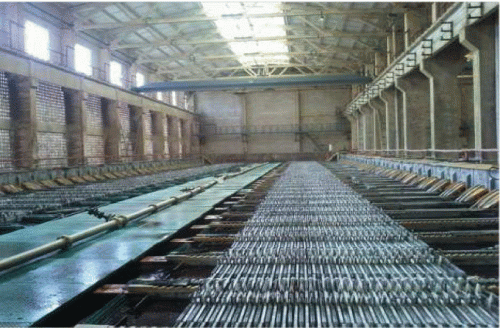In these days of social distancing, everyday electronic devices such as cell phones and laptops are more crucial than ever. But many of these devices, ubiquitous as they are, contain materials that are difficult to come by, called scarce rare earth and specialty elements (RESEs). For example, audio equipment such as speakers, headphones and microphones, frequently contain neodymium magnets.1 Every iPhone contains eight different rare-earth metals and some smart phones have as many as seventeen rare-earth metals.2

However, there is a problem, and it’s serious: for many RESE’s, current demand is outstripping the available supply rates.3 The situation could soon become even worse, because many wind and solar energy technologies also rely on RESEs.3 To make the problem even more dire, less than 5% of RESEs are currently recycled.4 Most likely, your last cell phone is buried in a landfill! This is clearly not sustainable and a significant effort is being directed towards ways to improve both the technology and the community infrastructure to improve this situation.
One of the most popular methods of recycling metals is electrowinning.5-7 This process begins by digesting used products such as electronics with a strong acid, creating a mixture of metal ions in what is commonly referred to as an electronic waste (e-waste) stream. Metals are then recovered from the e-waste by causing the dissolved metal ions to deposit as solid metal atoms onto a negatively charged stainless steel or aluminum sheet.

This technique works quite well for many bulk metals such as nickel and zinc,9,10 but the requirement for large and smooth sheets of aluminum or stainless steel mean that a typical electrowinning operation requires a significant amount of space (think of a huge warehouse) to be economically viable. Unfortunately, this conventional approach, called electrodeposition, is impractical for the recovery of many RESEs because of their comparatively low concentrations in most e-waste streams (much less than 1%).3
Enter nanotechnology! A company called Nth Cycle (www.nthcycle.com) was started in 2017 to address the recovery of RESEs from e-waste. The founders were three environmental engineers: Desiree Plata (an Assistant Professor in the Chemical and Environmental Engineering Department at Yale), Megan O’Connor (Dr. Plata’s graduate student at the time), and Chad Vecitis (an Assistant Professor at Harvard at the time). They recognized that carbon nanotubes have unique properties, most notably their high surface area, conductivity and chemical stability that could help extract metals from e-waste using electrodeposition. In contrast to traditional electrowinning, the high surface area of carbon nanotubes means that the device ends up being the size of a large coffee cup rather than an industrial warehouse, making the recovery of RESE’s an economically viable proposition. As Nth Cycle CEO Megan O’Connor explains, “The company’s name really stems from the vision that we can recycle these (electronic) materials an unlimited number of times.”11
The history of Nth Cycle is a great example of how academic research can be turned into a business opportunity. Nth Cycle’s story began in 2011 when researchers at Harvard created carbon nanotube filters that could conduct electricity while water flowed through them.12-14 These electrochemical carbon nanotube filters could be used to help clean up contaminated water by inactivating viruses and removing undesirable organic chemicals.12-15 Professor Plata and her research team recognized that this new water treatment technology also had the potential to selectively remove and recover trace metals from waste streams. In a 2018 paper published in Environmental Science: Water Research & Technology they showed not only how these carbon nanotube filters could electrochemically separate RESE from e-waste streams, but also select which metal they recovered by tuning how much voltage was applied to the filter.16

The next step was to translate these scientific discoveries into a commercial enterprise. That process was catalyzed when Megan O’Connor, Nth Cycle’s CEO, was selected to be an entrepreneurial research fellow at Oak Ridge National Laboratory (ORNL). This two-year fellowship program sponsored by the US Department of Energy gives innovators access to the world-class science expertise at ORNL, and helps them on the business development side. The goal is to translate laboratory discoveries into viable products and successful businesses in the marketplace. Since then, Nth Cycle has secured additional funding from the National Science Foundation’s Small Business Innovation Research Program (think “Shark Tank” for scientists) and Megan was named one of Forbes 30 under 30 in Energy.
Although still in the research and development stage, Nth Cycle have recently opened up a new facility in the Boston area and completed their first pilot program. They are currently looking for commercial partners with whom they can scale the technology. So perhaps your next cell phone won’t end up in a landfill, but instead will be part of a new one.

REFERENCES
- Rohrig, B., Smartphones: Smart Chemistry. ChemMatters April/May 2015, pp 10-12.
- U.S. Department of Energy. Critical Materials Strategy. 2011.
- O’Connor, M. P.; Zimmerman, J. B.; Anastas, P. T.; Plata, D. L., A Strategy for Material Supply Chain Sustainability: Enabling a Circular Economy in the Electronics Industry through Green Engineering. ACS Sustainable Chemistry & Engineering. 2016, 4 (11), 5879-5888. DOI: 10.1021/acssuschemeng.6b01954
- Reck, B. K.; Graedel, T. E., Challenges in Metal Recycling. Science 2012, 337 (6095), 690-695. DOI: 10.1126/science.1217501
- Cooper, W. C. Advances and Future Prospects in Copper Electrowinning. Journal of Applied Electrochemistry, 1985, 15(6), 789–805. DOI: 10.1007/BF00614357
- Dubrovsky, M.; Huh, T.; Evans, J. W.; Carey, C. D., Fluidized-Bed Electrowinning of Metals – a Review. Hydrometallurgy Research, Development and Plant Practice. edited by K. Osseo-Asare and J. D. Miller, The Metallurgical Society of AIME, Warrendale, Pennsylvania, 1983, pp. 759–772.
- Kammel, R.; Eran, H. G.; Lieber, H. W., Review and Outlook on Continuous Metal Electrowinning and Recovery Processes from Aqueous-Solutions. Hydrometallurgy: Research, Development and Plant Practice, edited by K. Osseo-Asare and J. D. Miller, The Metallurgical Society of AIME, Warrendale, Pennsylvania, 1983, pp. 647–657.
- Yang, C.; Deng, S.; Li, Y.; Zhu, H.; Li, F. Optimal Control for Zinc Electrowinning Process With Current Switching. IEEE Access 2017, 5, 24688–24697. DOI: 10.1109/ACCESS.2017.2768068
- Kasper A.C., Gabriel A.P., de Oliveira E.L.B., de Freitas Juchneski N.C., Veit H.M. Electronic Waste Recycling. (eds) Electronic Waste. Topics in Mining, Metallurgy and Materials Engineering. Edited by Veit H., Moura Bernardes A. Springer, Cham. 2015.
DOI: 10.1007/978-3-319-15714-6_9 - Bertuol, D. A.; Amado, F. D. R.; Veit, H.; Ferreira, J. Z.; Bernardes, A. M., Recovery of Nickel and Cobalt from Spent NiMH Batteries by Electrowinning. Chemical Engineering & Technology, 2012, 35 (12), 2084-2092. DOI: 10.1002/ceat.201200283
- Jennings, E. Alumni Profile: Megan O’Connor ’12. Union College.
- Gao, G.; Vecitis, C. D., Electrochemical Carbon Nanotube Filter Oxidative Performance as a Function of Surface Chemistry. Environmental Science & Technology. 2011, 45 (22), 9726-9734.
DOI: 10.1021/es202271z - Vecitis, C. D.; Gao, G. D.; Liu, H., Electrochemical Carbon Nanotube Filter for Adsorption, Desorption, and Oxidation of Aqueous Dyes and Anions. Journal of Physical Chemistry C. 2011, 115 (9), 3621-3629. DOI: 10.1021/jp111844j
- Vecitis, C. D. et al. Electrochemical Multiwalled Carbon Nanotube Filter for Viral and Bacterial Removal and Inactivation. Environmental Science & Technology, 2011, 45 (8), 3672-3679. DOI: 10.1021/es2000062
- de Lannoy, C. F. et al. Aquatic Biofouling Prevention by Electrically Charged Nanocomposite Polymer Thin Film Membranes. Environmental Science & Technology, 2013, 47 (6), 2760-2768. DOI: 10.1021/es3045168
- O’Connor, M. P.; Coulthard, R. M.; Plata, D. L., Electrochemical deposition for the separation and recovery of metals using carbon nanotube-enabled filters. Environmental Science: Water Research & Technology, 2018, 4 (1), 58-66. DOI: 10.1039/C7EW00187H
Feature image by unsplash-logoCharles Deluvio
